Possible? That depends. But in seeing YouTube Vintage Computer Repair Tech Jan Beta (from Germany) video on this brought back some old memories! He powered up a Commodore 64 with a 10,000mah Cellphone Power Cell, and describes what he had to do, what functions are missing by doing so and how much power did the system takes up. He then tried to do the same with a stock Vic20.
Video Link:
https://www.youtube.com/watch?v=U5nrWfLmqR0 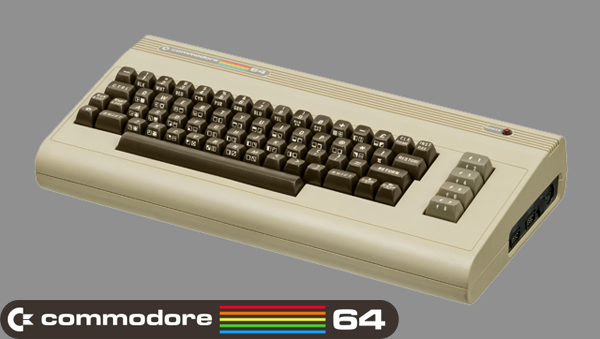
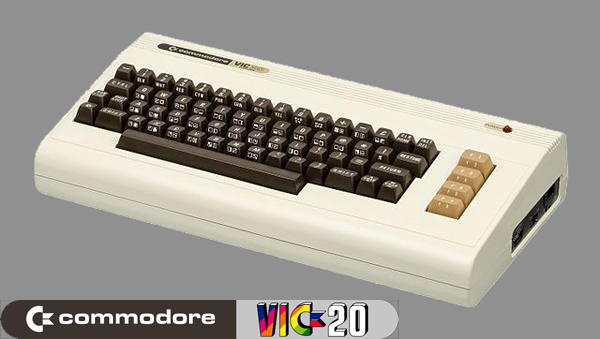 Details
Details Jan Beta discussed that there were two types of C64 boards: The Long Board and the Short Board. Both use a 7pin Din Connector with 2 pins for 5V and Ground and 2 pins for VAC. In theory, pumping in 5volts from another source, in this case a Cellphone Battery Power Cell, would be enough to turn on a the computer, or not. Let’s see...
The Boards? As state before, the Commodore 64 comes in one of two boards: the Long board and the Short Board – often called “Cost Reduced Board.”
The Long Board is the first version of the C64 that underwent various revisions but all have one thing in common, many of the chips on it use 12V as an input: The PLA (a task manager that switches the CPU and other chips for various operations), SID (Sound Interface Device) and Vic-II (Video Chip, 6567/6566 NTSC versions, and 6569 PAL version). Without the PAL and Vic II, the system cannot work on just pumping in 5V. The Long Board has its name from the board being long enough to reach from the back to the computer case to the front, and has about 28 chips on it, and made from 1983 to around 1988.
The Short Board was made around 1987 to be a cost reduction in the manufacture of the C64. It went from the back of the case to half way down on the case and with a lot less chips, with many of the addressing multiplexer chips being added to the PLA, making it larger and incompatible with the original PLA. Another cost reduction done was to modify the chips used on this version of the C64 to be only 5V chips. The Vic-II (8562/8564 NTSC versions, and 8565/8566 PAL versions), SID and PLA now only use 5V. Because of this the Commodore can be turned on with a 5V Cellphone Power Cell. There were two issues however: some of the SID Chips in these short boards were the 12V variant. To make the C64 work with the 12V SID, one has to remove the 12V SID with an option of replacing them with an ARM-SID or FPGA-SID, modern variants of the SOD replacement. One cannot replace a 12VSID with a 5VSID because of a couple pins being swapped around (the 12Vin and 5Vin pins), but the ARM-SID and FPGA-SID did not care what pins were where and can go into either C64 Socket. At worst, the C64 turns on with no sound but it turns on.
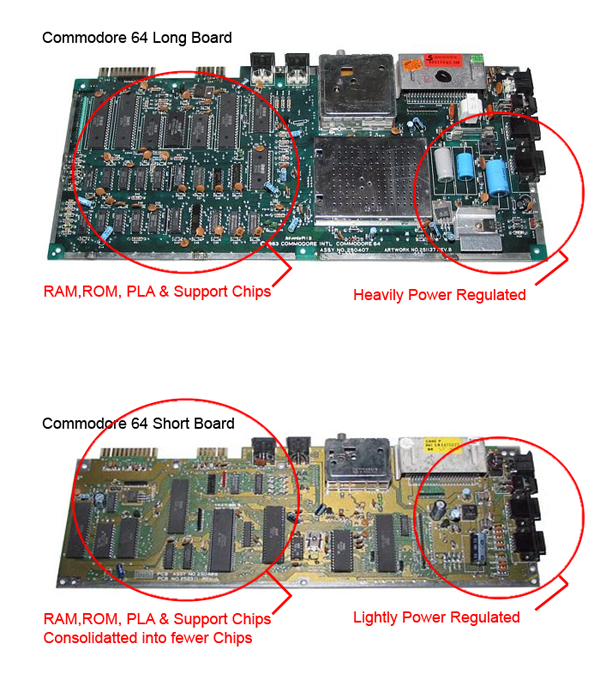
Another issue that is on both boards is two CIA (“Complex Interface Adaptor” 6526 & 8521) used the 9VAC oscillations to generate the system’s clock. Though general I/O will work on the Commodore 64, the system clock will not.
Power draw on the short board C64 is about .85mah with .45mah low when the C64 is just sitting there doing nothing.
A major issue is that the Short Board C64 is that it has minimal voltage regulation and one can damage the Short Board 64 if one tries to pump in more than 5volts into the system. The Short Board assumes that one will be using Commodore regulated Power Brick and not be pumping foreign voltages from who knows what devices. The Long Board C64 has built-in voltage regulation and is more robust to voltage input spikes.
The Commodore Cassette Drive and devices that uses the 9VAC from the user Port to power itself from the computer (like the VicModem) will not work as the 9VAC will be missing from the voltage input.
Despite these issues, the Short Board version of the Commodore 64 will work with a 5V Cellphone Power Pack. The Long Board version of the Commodore 64 will not work with just a 5V Cellphone Power Pack.
The Vic20, Apple IIc and others? Jan beta also tried to do turn on a Vic20 with the Cellphone Powercell Battery, assuming that it was a Short Board System. It worked, turning on and being functional like the C64. It pulled more power from the powercell battery pack, at about 1.15mah at a high and .65mah just sitting there doing nothing.
But here is where he and I differ.
He did the Vic 20 test without checking to see which Vic20 was used. Like the C64, there is a Long Board Version of Vic20 and Short Board Version of the Vic20. And like the C64, the Short Board Version of the Vic20 has minimal voltage regulation. But unlike the C64, the Vic20 does not have any chips that use 12V. The Vic20 uses 12V to power the Cassette Drive and any device that connects to the user port that requires power from the system.
As stated, the Vic20 has a Long Board and Short Board versions.
The Long Board version was developed in 1979 and has 2 sub-versions: 9VAC only (1979 – 1981) and 5V + 9VAC like as used on the Commodore 64 (1981 to 1984). It has about 28 Chips on the board and has a heavy duty power regulation circuitry.
The Short Board version was developed in 1983, using 5V + 9VAC like as used on the Commodore 64 (1983 to 1986+). It consolidates many chips on the board reducing the chip count from about 28 to about 16 and has a minimal power regulation circuitry like the short board C64.
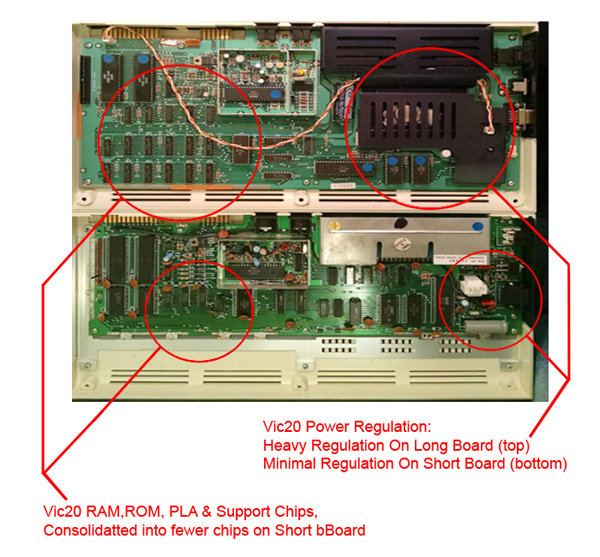
The Vic20 was discontinued in 1986, it was still in production until 1988 and still being sold into 1990 when stock of the Vic20 finally ran out. Commodore, in discontinuing the Vic20, only stopped producing the custom chips for it and stopped adding it to the computer market. But they made so many chips and boards that they continued producing the Vic20 until they ran out of stock. Not included in their number of the almost 3million sold Vic20s are custom made units for the video/radio and travel markets. Teleprompters, Commercial/Show Timers, Automated Video Editors (The Vic20 used to automate the video tape cutting machines and not the actual mixing of video signals with a Gen Locking board as on the Amiga System) and other items were used for the TV and Radio industry. Other custom Vic 20s were used as Large Screen Bulletin Board System for airport, bus terminal and train terminal arrival and departure automated displays.
Being of an older design based on the Commodore PET, the Vic20 used the 6522 VIA (Versatile Interface Adapter) interface chips. Commodore helped MOS develop a series of interface chips with various functions and abilities, starting with the 6520 CIA (Communications interface Adapter) and ending with the 6526 & 8521 used on C64, C128, Plus4/C16 and other Non-Commodore systems (serial and parallel cards on the Apple II and IBM PCs). Unlike the PIA used on the C64, the 6522 VIA had their own clock circuitry that used the system clock that ran the CPU, video and other I/O. Thus the clock on the Vic20 was still running if one used a battery to turn it on when it won’t on the C64.
Thus off the shelf without verifying what kind of Vic20 it was (Long Board or Short Board), Jan beta plugged the Vic20 onto the Cellphone Powercell and it worked. The only thing that did not work was the Cassette Drive because that requires the 12V line to be working when it would not be without added power for it. Like with the C64, he played a couple of games on it to prove that it did work.
Personal Arguments In my past I had created battery powered systems since the 1980s for one reason or another. Most were using a 12v motorcycle battery with a regulation board to power the system. One such unit was for a friend of mine in covert operations, using a small screen HP terminal on a battery (
https://www.hpmuseum.net/display_item.php?hw=34). But the weight and size of this thing would not make the task covert. Using a Vic20 and a 4in battery powered mini TV, we were able to create something for the task that was more than half the weight and size contained inside a slightly larger brief case. The Vic20 has added RAM with a battery back up to store what information we found and a modified VicModem with phone line connectors to access the lines we were tapping into. The mission was a success and the motorcycle battery still had power to run for several days. In fact, though this first mission was under my supervision in its construct and application, my friend made one for himself and continued with such covert information gathering for the remainder of his years. Thus operating a Vic20 on a battery was something I already knew how to do, and with the extra power being put in, it was able to use the cassette drive for data storage.
Another friend wanted his car to be computerized like KITT on the Knight Rider TV Series. Using a couple Timex Sinclair ZX81s and a couple modified CB Radios, he was able to create remote automotive system with a task manager for the job he did as an undercover investigator. Interfacing the ZX81 to a car’s 12v system was not difficult to power it. Interfacing the ZX81 into the car to be remotely controlled was another matter (LOL!). But was done; it could not be driven remotely, but lights, sirens, anti-theft system and even a 2way communications system was made for it for one to literally talk to the car and my friend’s voice would reply with the ZX81s controlling the CB Radios for this two-way communications to happen.
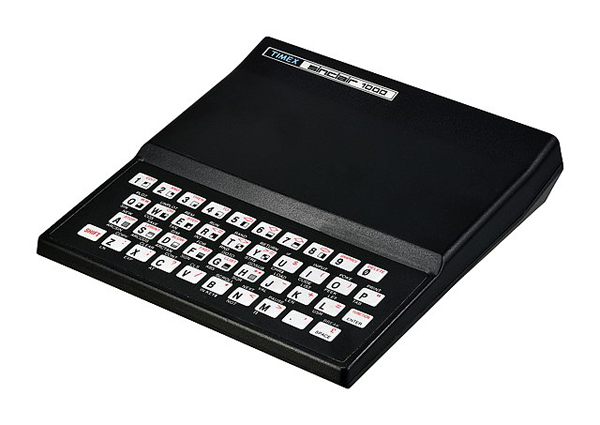
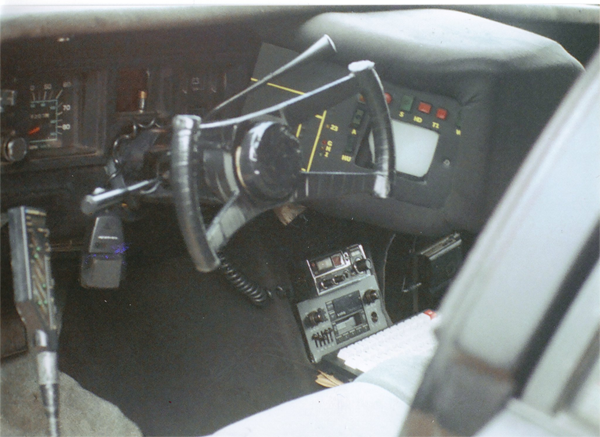
I had a similar idea for adding an Atari 400 into my VW Rabbit which I called “Jack Rabbit”, a semi automated, remote controlled, anti-theft system, “James Bond” gadget loaded car. The designed called upon using the 4 joystick/paddle ports as an interface to the rest of the car, had a basic OS on Cartridge and in case of unforeseen emergency – a self destruct system which involved a sparkplug in the gas tank and a few M80s tied in to various locations. The system was ready to be installed on the day the car was stolen.
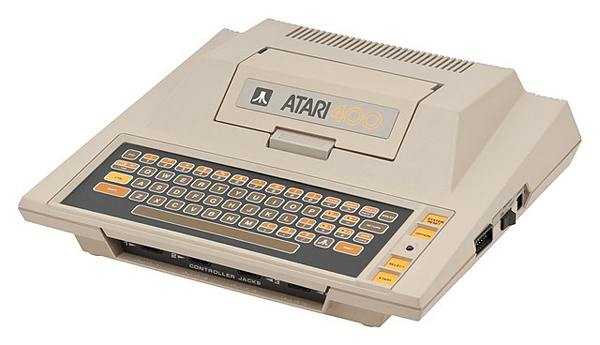
Years later, a friend needed an old Apple II Plus system to be battery operated for some research he was doing. The issue was that the Apple II Power Supply Unit (PSU) did all the voltage filtration and there was no voltage regulation on the mother board like the past mentioned systems had. We had to design a battery package and regulation system that plugged into the board similar to the Apple II PSU and allowed the battery to be recharged when plugged in and not in use. It was a major undertaking but we managed to do it. Mind you, some today would say how easy this would be to do, but back in the mid 1980s obtaining such parts to do this was hard and expensive. We were able to get such parts from my friend’s university connections as “Research Professor” for his school.
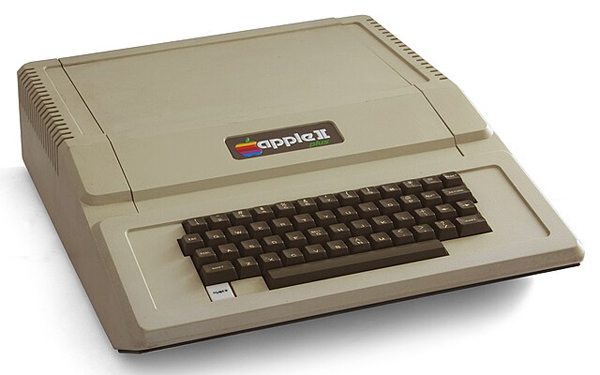
Not too long after that, I was given a personal task to power an Apple IIc with a battery after this friend saw it done on the movie Space Odyssey: 2010. It had to be fully functional as a portable unit, using the Apple IIc LCD Panel (a rather ugly thing by the opinion of many). Simply put one can throw in a small motorcycle or video camera 12v – 15v battery directly to the Apple IIc Power Port and the built-in PSU would do the regulation. A bit clumsy but doable, making the IIc as the first portable “laptop.” Problem: the PSU inside the Apple II was very power hungry and can run out a small video camera battery in under an hour or a small motorcycle battery in under 3 hours. Everything on the Apple IIc works including the LCD screen, but the short battery life only allowed limited use of the system.
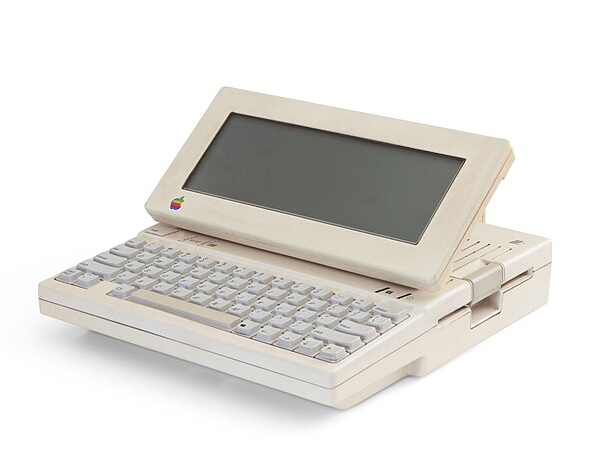
Not exactly a computer, but around this time another friend wanted an Atari 2600 running inside his van for his friends and children to play games while he drove. Like adding the ZX81 into the other friend’s car, it was fairly simple to do. The only issue was extending the joystick cables to reach those who wanted to play.
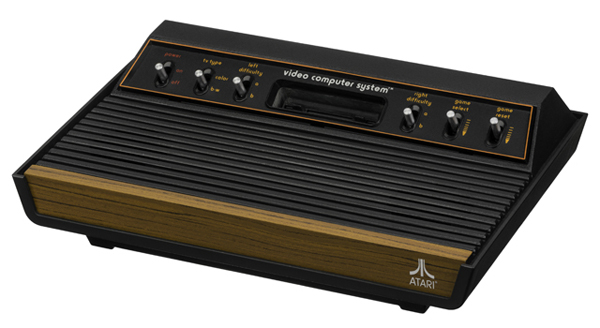
Not too long ago, I was connecting Raspberry and other Pi systems to Cellphone Powercell units for various robotics and remote data acquisition. The findings I had in those times was that these systems were very low powered and can run on a small Cellphone Powercell directly for an hour to an hour and a half. But these Pi systems were not old 8Bit systems, but HMOS technology 32bit system only requiring 3.3 to 5 volts to run on. Older 8Bit systems were TTL or MOS technology requiring 5volts at a minimum of half an amp to run.
Back in the 1980s, I did manage to take apart my Vic20 and replace as many chips inside it with CMOS Versions of the TTL/MOS chips it had. The 6502 CPU, and the 6522 VIAs were three of the main chips I switched out. This brought down power consumption of the Vic20 and kept it cooler in operation, while giving it a 10% speed boost in some of the operations; CMOS Chips only require 3.5 to 5 volts of power at .25 of an amp, about half of the power a TTL/MOS version would need. The only issue with CMOS Chips (then and now) is that they are very static sensitive, and can be destroyed with a small static shock without the user being aware of it. It being my first system, I still have it with the modifications I put into it still running on it.

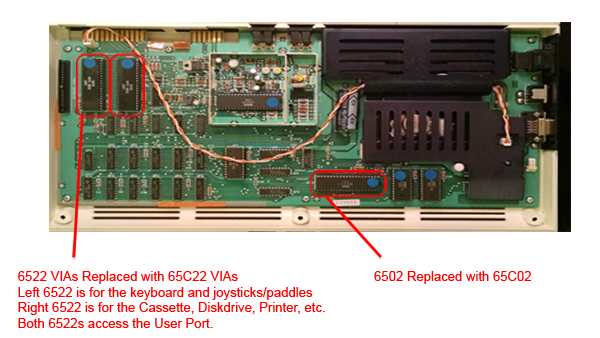 Conclusion:
Conclusion: With today’s tech one can connect an old 8Bit system to a small battery pack to power it; but because of the older chip technology used on the older 8bit systems can make battery life on such systems short. Some of the lessons I learned was to replace what standard chips there were with CMOS variants to increase battery life but to be cautious during the swap/installation as CMOS Chips are very static sensitive. Once in circuit, the circuit provides some static protection to the CMOS Chip. CMOS Chips from my experience can extend battery life almost 100%, or double what TTL/MOS Chips can provide, while giving a slight boost in processing.
But today’s technology can emulate the older 8bit hardware and be battery operated (aka: Laptop and Palmtop form factors) in software and hardware. But it is better than Bare Metal? That depends on what one wants. New technology limits what one can do in interfacing hardware for remote operations and data acquisition while older tech allows the creation of custom hardware to be connected to the system. Compatibility with older sensors may not exist to connect to modern equipment. This is an issue with manufacture and health care industries where older equipment cannot interface with newer systems. At least with manufacture, there are small companies willing to recreate the older systems to replace those systems that have worn down over time. But this is not true for the health care industry, where certain proven technologies are used until they are no longer functional and there are no replacements for them. Thus Old Tech has to be supported if its use is going to be needed in the present and future days.
 Pages: 1
Pages: 1
 Pages: 1
Pages: 1
 Pages: 1
Pages: 1
 Pages: 1
Pages: 1